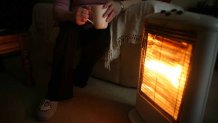The first widespread snowstorm of the season hit New England earlier this month, shocking the sensibilities of those hoping to delay the arrival of full-blown winter for as long as possible.
The storm was a reminder that yes, it's now the season for snow blowers, space savers, ice scrapers and gloves.
New Englanders know that it's always better to be over-prepared for the cold months rather than scramble to take the necessary steps to brace yourself and your family for the brutal cold.
These tips will help ensure that you, your home, your car, and everything else are ready for the cold weather.
BUNDLE UP, IN STYLE
First things first: When you venture outside in the cold, it's wise to dress properly. The Red Cross recommends wearing multiple layers of clothing, a hat, mittens and waterproof, insulated boots.

Alisa Neely, a style consultant who launched the website Style Scout, says fashionable winter dressing isn't impossible — but it's not always easy. The first thing to think about when planning your winter wardrobe is to invest in core items: A warm, but smart-looking wool coat, boots to navigate the icy streets and a few fabulous hats and scarves to stave off the winter chill.
In particular, Neely says to invest in a great coat. It doesn't have to be black -- she has a fantastic blue and black plaid coat that is often the centerpiece of her whole outfit.
Canada Goose recommends the Erickson Parka for men and Elmwood Parka or Aldridge Parka for women. While they are on the more expensive side, they are made to be flexible and adaptable, keeping you warm and on the go all winter long.
Neely says that a puffer coat isn't the only coat out there that will keep you warm -- there are incredible, long wool coats that are well made that can keep you just as warm. Look for one that is duster length.
She suggests luxurious layers like cashmere sweaters for underneath. Layers are the key to survival here in New England. There are some stylish bodysuits at places like Uniqulo and Wolford that make perfect layering pieces for the coldest of days, Neely says.
The same goes for boots. You are going to need more than one pair. There are boots that are practical but also have a short block heel with treads to make navigating the slippery streets easier.
Make sure whatever the footwear is, you have it weather treated. Nothing ruins a look faster than a salt-stained shoe. You can also have your cobbler put a rubber sole saver on the bottom of the shoe or boot to help protect it from water damage to the sole.
The final thing you can do is to invest in the most fabulous hats and scarves you can find. Instead of going for something basic, go for something fantastic. The oversized scarves at Patch NYC here in Boston are some of Neely’s all-time favorites, with patterns and colors add to any winter outfit.
STAYING SAFE
You should remember to rest and be careful when doing strenuous tasks like shoveling snow in the cold. Be cautious about being outside for long periods of time. You need to watch for hypothermia and frostbite.
According to the Red Cross, symptoms of hypothermia include, “confusion, dizziness, exhaustion and severe shivering and frostbite symptoms include numbness, flushed gray, white, blue or yellow skin discoloration, numbness or waxy feeling skin.”

You should always be aware, check on your neighbors and make sure they are warm and safe. Especially elderly people who live alone, people with disabilities and children.
You should bring your pets indoors. If they can’t come inside, the Red Cross recommends that they have enough shelter to keep warm and unfrozen water that they can drink.
AT HOME
Now that you are warm, you want to make sure your home is too. Installing weather stripping, insulation and storm windows are all important ways to keep the cold out and the warmth in.
You should also consider insulating any water lines that run along the exterior of your house, cleaning out your gutters and repairing roof leaks.
While you try to stay warm, you'll want to be careful using space heaters and other sources to keep your house warm. “Home heating is the second leading cause of fires in this country,” according to the Red Cross.
To reduce the risk of heat related fires, you should give the heat space. Be sure to keep children, pets and things that can burn - paper, matches, bedding, furniture, clothing, carpets and rugs - at least three feet away from heating equipment.

Be sure to place heaters on a level, hard and nonflammable surface. When you leave a room or go to sleep you should turn off portable space heaters.
Also be sure to never leave a fire in the fireplace unattended and have a glass or metal fire screen around the fireplace to keep the fire and embers from leaving. The Red Cross also says that you should never use your cooking range or oven to heat your house.
YOUR CAR
When it comes to your car, you'll want to make sure it is just as prepared as you and your house.
You should check the tire treads on your car, and if necessary, replace tires with all-weather or snow tires.
You should service the car’s radiator and refill antifreeze to the appropriate level. It is important to use a wintertime formula in your windshield washer, as well.
To avoid ice in the tank and fuel lines keep your gas tank full, experts say.
“Have the battery and charging system tested if your vehicle's battery is more than three years old,” AAA says. If the temperature drops to zero, even a good battery can lose up to 50 percent of its capacity.

You should also check your windshield washer fluid. You want to look for washer fluid that protects well below freezing temperatures as other kinds can freeze in the chilling temperatures.
During snowstorms and severe weather ,you should stay off the road if possible.
If you have to drive in winter weather, be sure to follow these tips from the Red Cross.
Be sure that everyone in the car has their seatbelts on, give the road your undivided attention, get yourself space as it is difficult to stop on snowy roads.
You should not pass snow plows and you should give them space. Beware of ramps, bridges and overpasses that freeze before roads do. You should also refrain from using cruise control during winter weather.
Mary Maguire from AAA tells us, “Drivers should also pack a winter emergency kit to keep in their car, especially if they’re travelling with children.” She goes on to say, “Jumper cables can get you on the move again quickly, and if you’re compelled to wait for help at the roadside, you want to make sure you and your children can stay warm and hydrated.”
AAA says that your kit should contain jumper cables, de-icer, a flashlight, phone charger, flares, blankets, water and snacks.

